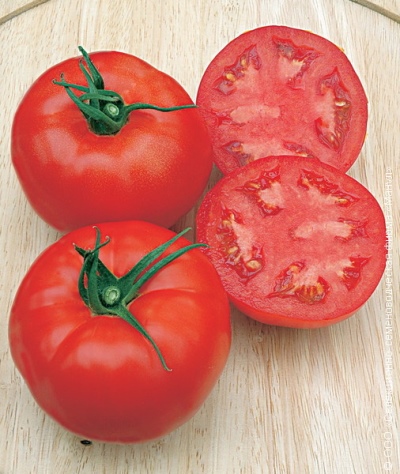
- Authors: Borisov A.V., Nalizhity V.M., Skachko V.A., Zhemchugov D.V.
- Year of approval: 2007
- Category: hybrid
- Growth type: determinant
- Appointment: fresh consumption
- Ripening period: mid-season
- Ripening time, days: 115-120
- Growing conditions: for open ground, for closed ground
- Marketable fruit yield,%: 65-87
- Bush size: undersized
Judging by the growing army of fans, the determinant hybrid Katyusha (synonym Katyusha F1) enjoys great attention of gardeners. Tomato has a strong immunity, high marketable yield (65-87%) of fruits, decorative properties, long-term storage capacity and good transportability. The originators claim that tomatoes are intended for fresh consumption, but gardeners contradict them. Many people use Katyusha in canning, and are happy with the results. The hybrid is grown in covered greenhouses, as well as in open ground.
Breeding history
The tomato was included in Rosreestr in 2007. The originators of the hybrid are the breeders of the Manul Selection and Seed Company Ltd. A. V. Borisov, V. M. Nalizhity, V. A. Skachko, D. V. Zhemchugov.
Description of the variety
Standard, low, compact (60-80 cm) medium-leafed bushes have a green stem covered with oval-pointed leaves. The first inflorescence is laid over 7-8 leaves, then after 1-2 cuttings. The brush ties 5 to 6 berries firmly attached to the articulated peduncle.
Pros of a hybrid:
great taste;
disease resistance;
resistance to temperature extremes;
long keeping quality and the possibility of transportation.
Minuses:
strong dependence on agricultural practices;
possible breaking off of shoots;
demanding food.
Despite the fact that tomato is recommended for cultivation by experienced tomato growers, careful attention to agricultural technology allows even a beginner to grow a plant.
The main qualities of the fruit
Light green flat-round fruits change color to bright red when fully ripe. The berry weighs 90-180 grams or more. Some gardeners manage to get tomatoes up to 330 g.
Taste characteristics
The pulp is fleshy and dense, covered with a smooth skin, contains a small amount of seeds, 4.8% dry matter. The balanced sweet taste with added sourness seems to be quite spicy and pleasant.
Ripening and fruiting
The hybrid is mid-season, the approximate ripening period is from 115 to 120 days.
Yield
A yield tomato yields up to 4-5 kg per bush, in the Central Black Sea Region they collect from 159 to 533 centners per hectare, and in the Far Eastern District - from 240 to 423 centners per hectare.
The timing of planting seedlings and planting in the ground
Since the seedlings are transferred to a permanent place after 60-65 days, the timing of sowing seeds depends entirely on the characteristics of the local climate.

Growing tomato seedlings is an extremely important process, because it largely depends on whether the gardener can harvest at all. All aspects must be taken into account, from seedbed preparation to planting in the ground.
Landing scheme
The recommended planting density is 4 sprouts per 1 m2, according to the scheme 50x50 or 70x30 cm.

Growing and caring
The tomato is grown in seedlings, the seedlings are transferred to a permanent place after a two-week hardening procedure. For cultivation in the exhaust gas, a well-lit area is chosen, fenced off from strong drafts and winds. The pH level should be neutral, the soil should be fertile and breathable. If the soil does not meet any parameters, it will be necessary to take the necessary measures to improve the structure and composition. Prepared ridges are enriched with organic matter (humus, compost, bird droppings), mineral fertilizers, ash. Supports are installed in each hole, since the trunk will not withstand the weight of the pouring fruits and will fall.
It is imperative to form a bush into one stem and tie it up. Grasshopping prevents thickening of the plantings and makes it possible to ventilate the inside of the bush. If the plant is grown in greenhouses, then the owner must take care of maintaining an optimal microclimate and humidity in order to prevent late blight, naked slugs and whiteflies. Timely watering and weeding will help the plant to fully develop. A high-yielding hybrid quickly depletes the soil, so after 2-3 weeks it will need nitrogen fertilization to stimulate flowering and ovary formation. During the budding period, phosphorus-potassium fertilizers are applied. Experienced gardeners during the season feed tomato rows several times with nettle infusion with the addition of bread leftovers. The introduction of a solution of a fresh mullein has no less effect. Each bush is spilled with the composition, trying not to fall on the foliage, the soil is shed well beforehand. Loosening can be replaced by mulching; covering the soil with a black non-woven material will save you from weeding. Today this method is becoming more and more popular. At the same time, the earth breathes well, and weeds cannot grow without sunlight.




A plant needs different micronutrients at each stage of growth. All fertilizers can be divided into two groups: mineral and organic. Folk remedies are often used: iodine, yeast, bird droppings, eggshells.
It is important to observe the rate and period of feeding. This also applies to folk remedies and organic fertilizers.
Disease and pest resistance
The strong immunity of the hybrid helps it to successfully resist cladosporia, TMV, and fusarium wilt.However, in the fight against phomosis, dry spot, whitefly, spider mite and Colorado potato beetle, it is clearly outsiders. Based on this, it should be concluded that insecticidal and fungicidal prophylaxis is mandatory.


Resistant to adverse weather conditions
Katyusha shows a fighting character, perfectly withstands extreme weather conditions - heat, cold snap and short-term drought.
Growing regions
The hybrid can be grown in the Central Black Earth Region and the Far East region, but it can also grow in other regions - Siberia, the Urals, the middle belt, the Volgo-Vyatka region and other territories.

























































































